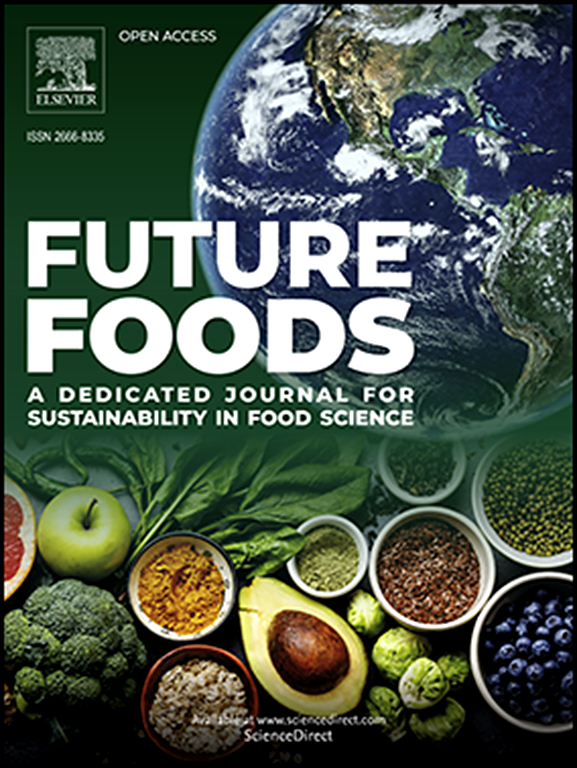共同研磨的食用摩洛哥坚果油(Argania spinosa L.)和牛至叶(Origanum vulgare L.)在食品应用中的协同潜力
IF 7.2
Q1 FOOD SCIENCE & TECHNOLOGY
引用次数: 0
摘要
在萃取过程中加入牛至(Origanum vulgare L.)叶(OL),可以显著提高摩洛哥坚果油(AO)的营养保健功效。这要归功于所采用的技术(萃取富集),而无需借助有机溶剂。目前的工作旨在开发一种含有 2% 和 5% OL 的绿色摩洛哥坚果油浓缩方法。这项研究的目的是评估在四个月的加速氧化条件下,添加 OL 的效果及其对阿甘油氧化稳定性的影响。在整个贮藏期间,橄榄油的理化特征包括质量指标、总酚含量、抗氧化活性、色素和感官分析。总的来说,含有 OL 的 AO 样品的酚类、叶绿素和类胡萝卜素含量增加,过氧化值和对甲氧基苯胺值降低。由于 OL 减慢了脂质完全氧化的过程,杏仁油的保质期得以延长。从感官角度来看,未富集的 AO 有一种酸败的味道,而添加了 5% OL 的 AO 牛至的味道和颜色则更加浓郁。这种创新方法提高了 AO 在各行各业中的价值,并体现了当我们探索不同天然元素之间的协同作用时所产生的无限可能性。本文章由计算机程序翻译,如有差异,请以英文原文为准。
Synergistic potential of co-millinged edible argan oil (Argania spinosa L.) and oregano leaves (Origanum vulgare L.) in food applications
By including oregano (Origanum vulgare L.) leaves (OL) during the extraction process, the nutraceutical benefits of argan oil (AO) can be significantly increased. Thanks to the employed technique (enrichment through extraction), without resorting to organic solvents. The current work aimed at developing of a green enrichment of argan oil with 2 and 5 % of OL. The purpose of this research was to evaluate the effectiveness of adding OL and its impact on AO oxidative stability under accelerated oxidation for four months. AO physicochemical characterization consisted in measuring quality indices, total phenolic contents, antioxidant activity, pigments, and sensory analysis throughout the storage period. In general, AO samples containing OL exhibited increased phenolic, chlorophylls, and carotenoid contents and lower peroxide and p-anisidine values. AO shelf-life was extended thanks to OL, which slowed down the process of lipid complete oxidation. From a sensory standpoint, a rancid taste was found in the unenriched AO, while the taste and color of oregano were more intense in the AOs supplemented with OL at 5 %. This innovative approach boost AO value in various industries and exemplifies the endless possibilities that emerge when we explore the synergy between different natural elements.
求助全文
通过发布文献求助,成功后即可免费获取论文全文。
去求助
来源期刊

Future Foods
Agricultural and Biological Sciences-Food Science
CiteScore
8.60
自引率
0.00%
发文量
97
审稿时长
15 weeks
期刊介绍:
Future Foods is a specialized journal that is dedicated to tackling the challenges posed by climate change and the need for sustainability in the realm of food production. The journal recognizes the imperative to transform current food manufacturing and consumption practices to meet the dietary needs of a burgeoning global population while simultaneously curbing environmental degradation.
The mission of Future Foods is to disseminate research that aligns with the goal of fostering the development of innovative technologies and alternative food sources to establish more sustainable food systems. The journal is committed to publishing high-quality, peer-reviewed articles that contribute to the advancement of sustainable food practices.
Abstracting and indexing:
Scopus
Directory of Open Access Journals (DOAJ)
Emerging Sources Citation Index (ESCI)
SCImago Journal Rank (SJR)
SNIP
 求助内容:
求助内容: 应助结果提醒方式:
应助结果提醒方式:


